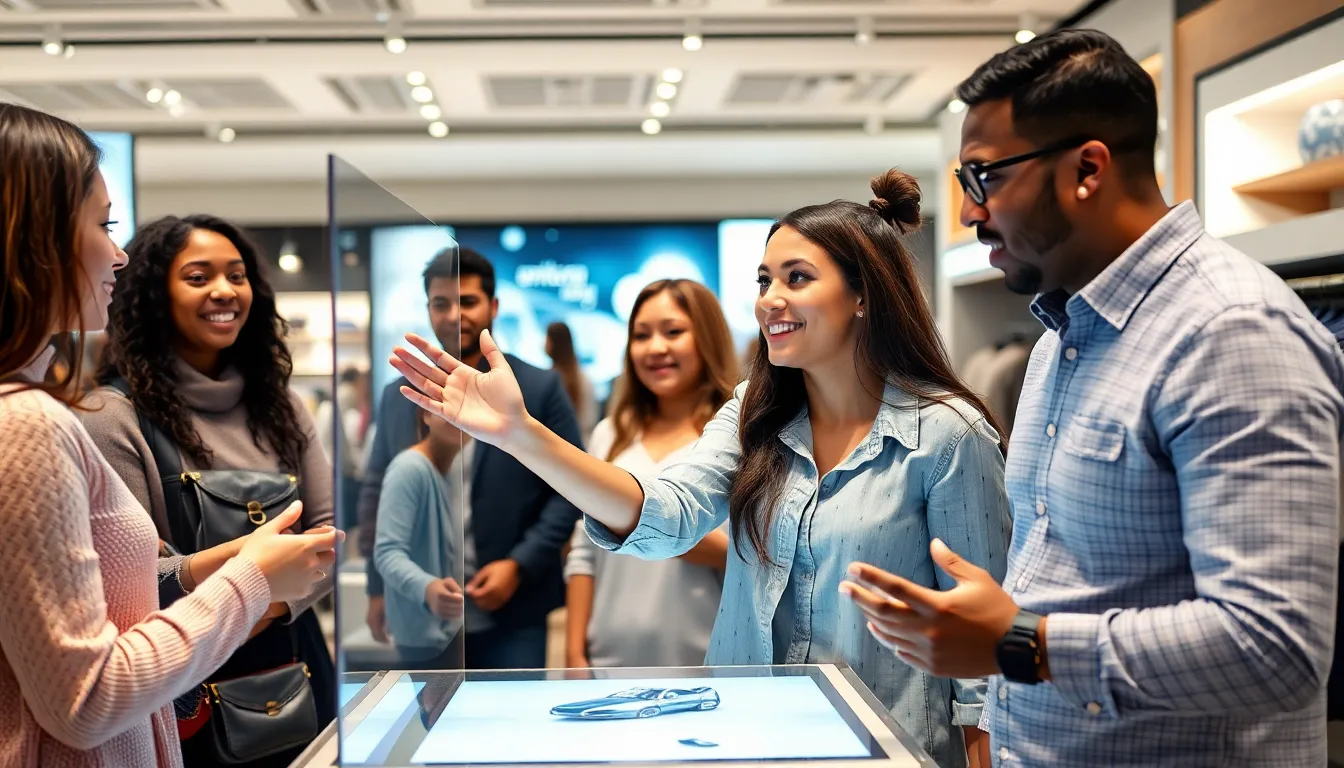In a world where online shopping is rapidly evolving, AR product demos are transforming the way consumers interact with products. By blending the digital and physical realms, augmented reality allows potential buyers to visualize items in their own environment, enhancing their shopping experience. This innovative technology not only captivates users but also drives engagement and boosts conversion rates.
As companies seek to stand out in a crowded marketplace, AR product demos offer a unique solution to showcase features and benefits in an immersive way. From furniture retailers to fashion brands, businesses are leveraging AR to create memorable experiences that resonate with customers. With the potential to revolutionize the retail landscape, understanding the impact of AR product demos is essential for brands aiming to stay ahead of the competition.
Table of Contents
ToggleOverview of AR Product Demos
AR product demos leverage augmented reality technology to create interactive and immersive shopping experiences. Businesses implement AR to allow customers to visualize products in their actual environments, enhancing decision-making processes. Brands utilize AR to demonstrate product features, sizes, colors, and functionalities before purchase, reducing uncertainties related to online shopping.
Key benefits of AR product demos include:
- Enhanced Engagement: AR captures consumer attention by offering unique interaction methods.
- Increased Conversion Rates: Interactive experiences lead to higher likelihoods of purchases.
- Reduced Return Rates: When customers view products accurately, dissatisfaction decreases.
- Improved Brand Loyalty: Engaging experiences foster lasting connections with consumers.
Various industries, such as furniture, fashion, and beauty, adopt AR product demos to stand out. Retailers like IKEA and Sephora exemplify the successful integration of AR into their marketing strategies, providing a competitive edge in the marketplace.
Benefits of AR Product Demos

AR product demos offer several advantages that significantly enhance the shopping experience. By integrating augmented reality into product displays, businesses capture consumer attention and foster deeper interactions.
Enhanced Customer Engagement
Enhanced customer engagement emerges as a primary benefit of AR product demos. AR allows users to interact with products in a dynamic way. Customers can manipulate virtual products, rotate them, and view them from different angles. Such immersive experiences captivate attention and encourage longer interaction times. Increased engagement leads to higher retention rates, allowing brands to forge stronger connections with their audience.
Improved Product Understanding
Improved product understanding represents another crucial advantage of AR product demos. By visualizing products in real environments, customers grasp size, scale, and functionality more effectively. This clarity reduces confusion and aids informed decision-making. Detailed exploration of product features through AR leads to more confident purchases, minimizing the likelihood of returns.
Technologies Behind AR Product Demos
AR product demos rely on various technologies to create immersive experiences that enhance consumer engagement. Understanding these technologies reveals how AR transforms online shopping.
Augmented Reality Platforms
Multiple platforms facilitate the creation and deployment of AR product demos. These include:
- ARKit: Developed by Apple, ARKit allows developers to build AR applications for iOS devices, offering advanced motion tracking, environmental understanding, and light estimation.
- ARCore: Google’s equivalent platform supports AR experiences on Android devices, enabling functions like motion tracking and environmental recognition.
- Web-based AR: Tools like 8th Wall and Zappar provide web-based AR capabilities, allowing users to access AR content through standard web browsers without app downloads.
- Unity and Unreal Engine: Popular game development engines that support AR app creation, allowing for intricate 3D modeling and animation to enhance user engagement.
These platforms offer diverse features, ensuring robust AR experiences across different devices and contexts.
Devices and Accessibility
The effectiveness of AR product demos hinges on the devices used to experience them. Key devices include:
- Smartphones: Most consumers access AR through smartphones, utilizing the built-in cameras and sensors for interactive experiences.
- Tablets: Larger screens provide enhanced viewing areas, making AR experiences more engaging for product visualization.
- AR Glasses: Devices like Microsoft HoloLens and Magic Leap offer hands-free experiences, ideal for complex interactions and professional applications in retail.
- Wearable Technology: Smartwatches and other wearables can support basic AR functions, extending accessibility.
Ensuring AR demos are compatible across these devices makes the technology more accessible, expanding its reach to a broader audience.
Best Practices for Creating AR Product Demos
Creating effective AR product demos requires a focus on user experience and engaging elements. By following best practices, businesses can maximize the effectiveness of their augmented reality presentations.
Designing User-Friendly Experiences
Designing user-friendly experiences ensures that AR product demos are accessible and intuitive. Key considerations include:
- Simplifying Navigation: Incorporate straightforward controls and clear instructions to guide users through the demo.
- Optimizing Load Times: Ensure fast loading times to minimize user frustration, enhancing engagement and retention.
- Providing Context: Offer relatable environments or scenarios where users can visualize the product’s application, such as home settings for furniture or real-life events for fashion items.
- Testing Usability: Conduct user testing to gather feedback, refining the demo based on user preferences and behaviors, ensuring a smooth interaction.
Integrating Visual and Audio Elements
Integrating visual and audio elements elevates the immersive quality of AR product demos. Important aspects include:
- High-Quality Graphics: Utilize detailed, realistic 3D models to enhance product representation, capturing users’ attention.
- Dynamic Animations: Include animations that showcase product functionality or features in action, providing a clearer understanding of usage.
- Complementary Sound Effects: Incorporate sound effects that correspond with user interactions, adding an extra layer of immersion and engagement.
- Narrative Voiceovers: Use voiceovers to explain product benefits and features, guiding users through the experience without overwhelming them with text.
Implementing these practices enhances user satisfaction and drives successful product interactions.
Case Studies of Successful AR Product Demos
IKEA Place
IKEA Place offers an exemplary case of AR product demos that revolutionize the furniture shopping experience. This app allows customers to virtually place furniture in their homes using AR technology. Users can visualize how specific items fit within their spaces, assessing size, style, and layout. This functionality leads to decreased uncertainty about purchases and significantly reduces return rates. Since its launch, IKEA reported a 20% increase in conversion rates attributed to this interactive experience.
Sephora Virtual Artist
Sephora’s Virtual Artist app exemplifies AR’s effectiveness in the beauty industry. The app enables users to virtually try on makeup products using their device’s camera. By providing personalized testing experiences, users can experiment with various shades and products without physical application. A study showed that users are 11 times more likely to purchase after engaging with the Virtual Artist feature, illustrating the app’s positive impact on sales.
Lowe’s Holoroom How To
Lowe’s Holoroom How To platform showcases AR’s ability to educate and engage customers effectively. This interactive tool guides users through home improvement projects using AR simulations. Customers can visualize steps in real time, which enhances their understanding of DIY tasks. This innovative approach not only elevates customer confidence but also drives in-store foot traffic for supplies related to completed projects.
Converse Sampler
Converse Sampler provides an excellent example of how AR can enhance consumer product experiences in the apparel segment. Using a mobile app, users can visualize different shoe styles and customize colors before making a purchase. This interactive experience personalizes the shopping journey, resulting in higher engagement rates. Internal reports indicated a 20% increase in sales due to the immersive experience allowed by the app.
Audius AR
Audius AR successfully integrates AR in the automotive industry by allowing potential buyers to visualize vehicles in their driveways. The Audius app provides a 360-degree view of vehicles and various customization options. Users can engage with the product at their convenience, leading to a more informed purchasing decision. Following the launch, Audi reported a notable increase in test drives and dealership visits, demonstrating the demo’s effectiveness.
Warby Parker Virtual Try-On
Warby Parker utilizes AR technology to enable customers to virtually try on glasses. This app lets users see how different frames look on their faces, enhancing visual understanding. The implementation of this feature led to increased online sales and elevated customer satisfaction. Post-launch surveys indicated that 90% of users valued the AR feature, associating it with their purchasing decisions.
Nike Fit
Nike Fit employs AR to assist customers in finding the perfect shoe size. By scanning their feet using the app, users receive precise sizing recommendations for various shoe models. This personalization reduces return rates and enhances customer loyalty. Nike reported that users of the Nike Fit feature showed a 30% increase in retention rates.
These case studies highlight the diverse applications and significant benefits of AR product demos across various industries. Each example illustrates how AR can transform the shopping experience, improving customer engagement and increasing conversion rates.
AR product demos are revolutionizing the online shopping landscape by offering consumers an interactive and immersive experience. This technology not only enhances engagement but also builds stronger connections between brands and customers. As retailers adopt AR, they’re not just improving sales; they’re also fostering brand loyalty by making shopping more enjoyable and informative.
The success stories from various industries underscore the effectiveness of AR in driving conversion rates and reducing return rates. By investing in high-quality AR experiences, businesses can stay ahead in a competitive market and meet the evolving expectations of today’s consumers. Embracing this innovative approach is essential for brands aiming to thrive in the digital age.


